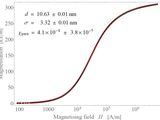Artificial materials
Magnetic characterisation is also a frequently used method for artificially produced materials to conduct basic research. Domains of application are for instance:
- condensed matter studies for the analysis of low and high temperature superconductivity, paramagnetic films, spin glasses, layered structures and others in a broad temperature and field range
- material sciences for magnetic characterisation of amorphous alloys, nanocomposite materials, thin films, superconductors and many others
- magnetochemistry for analysing the interaction of magnetic fields and atomic molecular structures, for instance metalloproteins like oxyhaemoglobine, magnetic ionic liquids, or rare earth element compounds such as gadolinium. The latter being used as contrast agent for magnetic resonance imaging (MRI)
Magnetic property measurements are deployed for magnetic (nano)material engineering, in order to verify if the synthesis process was successful in creating a material with desired specific magnetic properties. This aspect is important for the development of magnetic nanospheres for medical, technical and environmental applications. For example, measurements of saturation magnetisation near absolute zero and room temperature magnetisation curves can be used to determine particle size distributions of magnetic nanoparticles.
Example of magnetic grain size determination of superparamagnetic nanoparticles of a ferrofluid (cf explanantion below). The induced magnetisation curve (dots) of coated dry magnetite nanoparticles is fitted with the Langevin function (red line) taking into account grain size distribution and the paramagnetic coating of the nanoparticles. The nominal particle size provided by the manufacturer is 10 nm. The parameters d, σ, and χpara denote the mean particle diameter of the distribution, the distribution width and the paramagnetic susceptibility of the coating, respectively.
Ferrofluids consist of a carrier fluid which contains a colloidal suspension of nanometre sized crystalline particles, coated with an organic substance. Ferrofluids become strongly magnetised when exposed to magnetic fields. In biomedicine, ferrofluids are used for instance for:
- cell separation
- magnetofection, i.e. transfer of nucleic acids adhered to coated magnetic nanoparticles into target cells by means of magnetic fields
- magnetic hyperthermia, i.e. tumour treatment exploiting the heat generation by ferrofluids when exposed to alternating magnetic field

